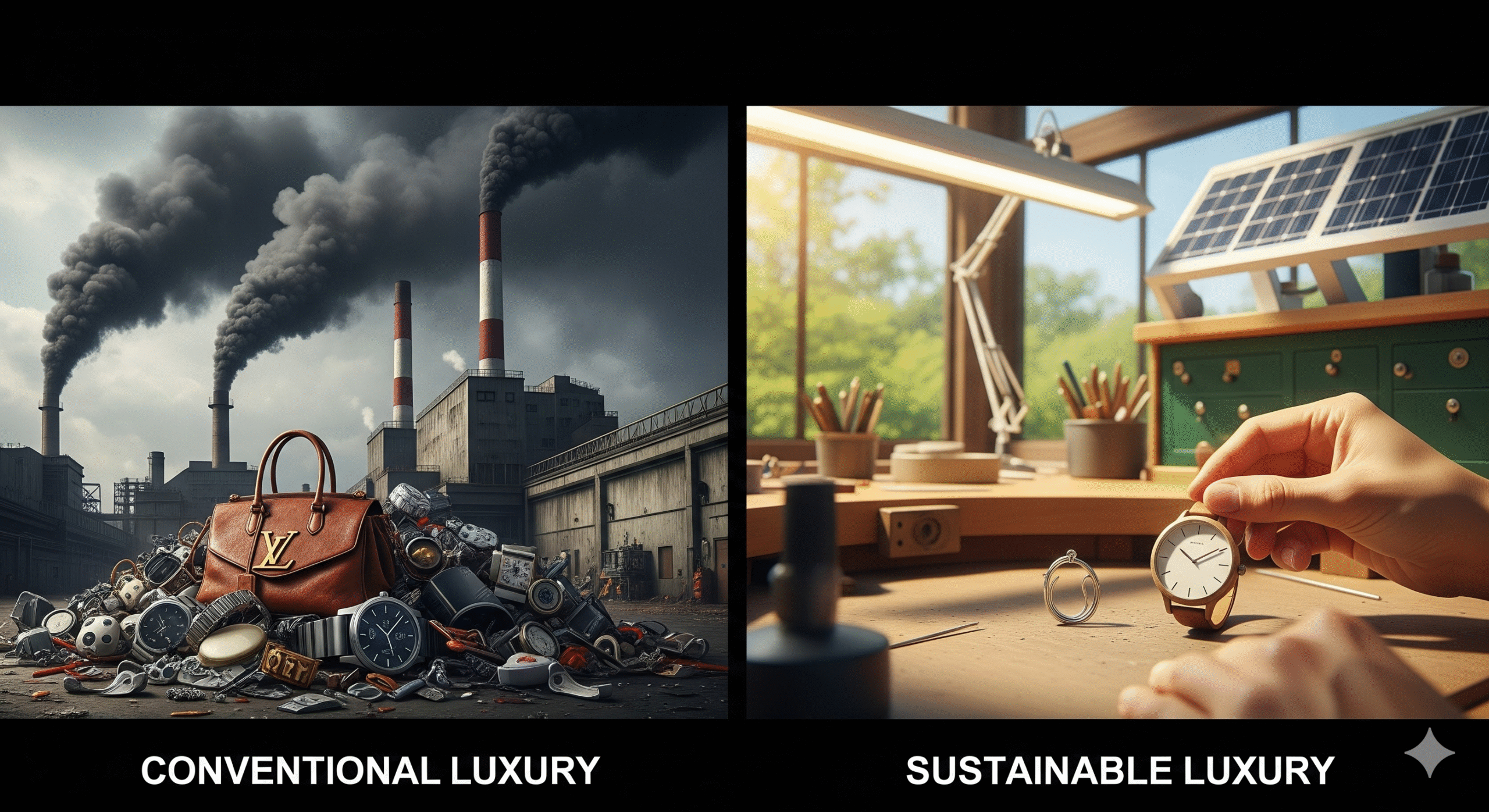For centuries, luxury has been defined by exclusivity, opulence, and a certain kind of unapologetic excess. The finer things in life—a bespoke handbag, a private jet, a meticulously crafted diamond—have long been symbols of status, often with little regard for their environmental or social cost. The industry has thrived on a model of high-speed production and consumption, leaving a trail of carbon footprints and ethical questions in its wake.
At first glance, the very phrase “sustainable luxury” seems like a contradiction in terms. How can an industry built on the pursuit of more, on rare materials and exclusive access, reconcile with the core principles of ecology, which demand less consumption, less waste, and greater ethical responsibility?
Yet, a quiet but powerful revolution is underway. A new generation of brands and consumers are proving that wealth and ecology are not mutually exclusive. They are forging a new path where the most valuable products are not just beautiful, but also kind to the planet and its people. This article will explore the rise of sustainable luxury, examining its core principles, its challenges, and its potential to redefine the very meaning of high-end consumerism.
The Backstory: A Shift from Conspicuous Consumption to Conscious Creation
To understand the rise of sustainable luxury, we must first look at the traditional model it is challenging. For decades, conventional luxury was rooted in “conspicuous consumption”—the public display of wealth through the purchase of goods and services. The value was in the rarity of the materials, the exclusivity of the brand, and the sheer extravagance of the product, regardless of how it was made. This led to practices that were often ethically and environmentally problematic:
- The use of exotic leathers and furs from endangered animals.
- Resource-intensive extraction of gold, silver, and diamonds.
- Highly polluting manufacturing processes with little to no transparency.
- A “take-make-dispose” linear model that generated enormous amounts of waste.
This model is no longer tenable, both for the planet and for a new generation of consumers. Millennials and Gen Z are not just buying products; they are buying into a brand’s values. They are demanding transparency, ethical sourcing, and a clear story behind what they consume. This shift has forced the luxury industry—long resistant to change—to adapt or risk becoming obsolete.
Sustainable luxury has emerged as the answer. It is a philosophy that redefines luxury not through material extravagance, but through the intrinsic value of its creation. It places equal importance on the quality of the product, its social and environmental impact, and the story of its origin. This new value system is proving that the ultimate luxury is not about what you own, but about how it was made.
A Tale of Two Luxuries: Conventional vs. Sustainable
The contrast between the old and new models of luxury is stark. While both aim for high quality and exclusivity, their fundamental approaches to materials, production, and purpose are worlds apart.
| Trait | Conventional Luxury | Sustainable Luxury |
| Materials | Rare & Resource-Intensive. Relies on virgin materials, exotic animal products, newly mined gems, and high-impact textiles. | Ethical & Innovative. Prioritizes recycled, upcycled, and bio-based materials (e.g., lab-grown diamonds, mushroom leather), and responsibly sourced natural fibers. |
| Production | Linear & Opaque. A “take-make-dispose” model. Supply chains are often complex and lack traceability. Labor practices may be questionable. | Circular & Transparent. Embraces a circular economy model (recycle, repair, reuse). Supply chains are fully traceable, and fair labor practices are a non-negotiable. |
| Craftsmanship | Exclusivity. Focuses on traditional techniques for rarity, often at high material cost and environmental impact. | Intentionality & Durability. Focuses on timeless design and durable construction to reduce waste. Craftsmanship is valued for its longevity and low impact. |
| Brand Identity | Status & Exclusivity. The value is in the brand name and the public display of wealth. The narrative is about aspiration and a perfect, unattainable lifestyle. | Purpose & Responsibility. The value is in the ethical story, the brand’s positive impact, and the consumer’s values. The narrative is about conscious consumption and a better world. |
| Carbon Footprint | High. From sourcing and manufacturing to transportation and waste disposal, the entire lifecycle is often carbon-intensive. | Low. Brands actively work to reduce their footprint through renewable energy, efficient logistics, and carbon offsetting. |
Export to Sheets
This table illustrates the core difference: conventional luxury sells an identity of wealth, while sustainable luxury sells an identity of values. The latter is about buying a beautiful product that you can feel good about—a new, deeper form of emotional satisfaction.
The Key Pillars of Sustainable Luxury
For a luxury brand to be truly sustainable, it must operate on a foundation of several key principles that guide every aspect of its business, from sourcing to sales.
1. Ethical Sourcing and Radical Transparency
The journey of a sustainable luxury product begins long before it hits the shelves. It starts with a commitment to knowing the origin of every material. This means:
- Conflict-Free Materials: Ensuring precious metals and stones are sourced from mines that do not fund conflict.
- Responsible Agriculture: Sourcing fibers like organic cotton or cashmere from farms that use sustainable and animal-friendly practices.
- Full Traceability: Using blockchain or other technologies to create a transparent supply chain that allows consumers to track their product’s journey from raw material to finished good.
2. Embracing the Circular Economy
Instead of the linear “take-make-dispose” model, sustainable luxury brands are embracing a circular economy. This means:
- Longevity and Durability: Products are designed to be timeless and built to last for generations, encouraging repair and resale.
- Upcycling and Recycling: Using materials from old products to create new ones. For example, brands are turning discarded ocean plastic into high-end fabrics or upcycling old luxury bags into new accessories.
- Repair Services: Offering lifetime repair services to extend the product’s life and foster a long-term relationship with the consumer.
3. Innovation in Materials and Technology
A key driver of sustainable luxury is the move away from traditional, high-impact materials and towards innovative, eco-friendly alternatives.
- Lab-Grown Diamonds: These gems are chemically identical to mined diamonds but are created in a controlled environment with a tiny fraction of the energy and environmental cost of mining. This technology is a game-changer for the fine jewelry sector.
- Bio-Based Fabrics and Leathers: Scientists are creating materials from plant-based sources like pineapple leaves, mushrooms (Mylo), and cactus (Desserto). These materials offer the look and feel of traditional leather without the environmental toll of animal agriculture.
- Renewable Energy: Brands are investing in sustainable manufacturing by powering their production facilities with renewable energy sources like solar and wind.
The Promise and The Peril: Pros and Cons
Like any emerging market, sustainable luxury has its own set of advantages and challenges.
Pros:
- Environmental Impact: A core benefit is the reduced ecological footprint of luxury goods, from less water consumption and lower carbon emissions to less waste generation.
- Enhanced Brand Reputation: Consumers are more likely to trust and be loyal to brands that demonstrate a genuine commitment to social and environmental responsibility.
- Market Growth & Innovation: The demand for sustainable products is driving innovation and creating a new, dynamic sector within the luxury market.
- Ethical Supply Chains: The focus on transparency and ethical sourcing ensures fair labor practices and better working conditions for everyone in the supply chain.
Cons:
- Greenwashing: The biggest threat to the integrity of this market is greenwashing—when brands falsely or misleadingly market their products as sustainable without any real commitment. This erodes consumer trust and can harm genuine efforts.
- Higher Costs: Sustainable materials, ethical labor, and circular production models often come with a higher initial cost. This can make the products even more exclusive, potentially limiting the market’s reach.
- Scalability Issues: While innovative, many sustainable materials and production methods are not yet scalable to the level of large-scale luxury manufacturing, which can create a bottleneck.
- Perception and Aesthetics: Some consumers still associate sustainability with lower quality or a “crunchy” aesthetic. The industry must work to prove that eco-friendly can also be beautiful, durable, and luxurious.
The Conscientious Consumer: Who Is Sustainable Luxury For?
This new market is not for everyone, but it is deeply appealing to a specific type of consumer who is looking for more than just a brand name.
- The Mindful Millennial and Gen Z: This demographic is highly conscious of its impact on the world. They view their purchasing power as a vote for the kind of world they want to live in. For them, sustainable luxury is not just an option; it’s a moral imperative.
- The Ethical Investor: High-net-worth individuals are increasingly aligning their investments with their values. This extends to their personal spending, as they seek out brands that reflect their commitment to ESG (Environmental, Social, and Governance) principles.
- The Eco-Conscious Traveler: This person seeks out luxury experiences that leave no trace. They will choose a private eco-resort that supports local communities over a sprawling, resource-intensive hotel.
- The Socially Responsible Philanthropist: For those who use their wealth for good, sustainable luxury offers a seamless way to integrate their ethical values into their daily life, making their consumption a form of conscious action.
FAQs: Your Questions on Sustainable Luxury Answered
Is a sustainable luxury product still authentic if it uses new materials?
Yes, authenticity in sustainable luxury is not tied to traditional materials. It is defined by the product’s origin story, the integrity of its supply chain, the craftsmanship behind its creation, and its positive impact. A lab-grown diamond, for example, is chemically and physically identical to a mined one, but its authenticity lies in its ethical origin.
Why are sustainable luxury products often more expensive?
The higher cost is a direct result of the brand’s commitment to ethical and responsible practices. This includes paying fair wages to artisans, investing in new, cleaner technologies, and using higher-quality, often more expensive, sustainable materials. The cost reflects a more just and sustainable production model.
How can I tell the difference between a truly sustainable brand and one that is greenwashing?
Look for transparency and third-party certifications. A truly sustainable brand will openly share information about its supply chain, labor practices, and environmental impact. Look for certifications from reputable organizations like Fair Trade, B Corp, or the Global Organic Textile Standard (GOTS). If a brand is vague about its sustainability claims, it’s a red flag.
Can the fashion industry ever be truly sustainable?
Complete sustainability is a high bar, but the fashion industry is making significant progress. By embracing the circular economy, using innovative materials, and prioritizing durability over fast fashion, brands are dramatically reducing their impact. The key is a shift from high-volume, low-cost production to a focus on high-quality, timeless pieces.
What is the biggest challenge for the future of sustainable luxury?
The biggest challenge is scalability. While many sustainable innovations exist, scaling them up to meet global demand without compromising their ethical and environmental integrity is a major hurdle. However, as demand grows, investment will follow, helping to solve this problem.
Conclusion: A New Definition of Value
The notion of sustainable luxury is no longer an oxymoron. It is a powerful new paradigm that challenges the very foundations of the luxury industry. It recognizes that in a world of finite resources and growing social inequality, true luxury cannot come at a cost to the planet or its people.
This revolution is redefining luxury not as a fleeting symbol of status, but as a long-lasting testament to craftsmanship, values, and a positive legacy. It is about an heirloom that tells a beautiful story—not just of its making, but of its impact.
Final Verdict: Can wealth and ecology coexist? The answer is a resounding yes. The future of luxury is not about more; it is about better. It is about a world where the most coveted objects are those that carry a deep sense of purpose, integrity, and respect for our shared home. Sustainable luxury is not just a trend—it is a new, more profound, and more honest definition of wealth itself.







Leave a Reply